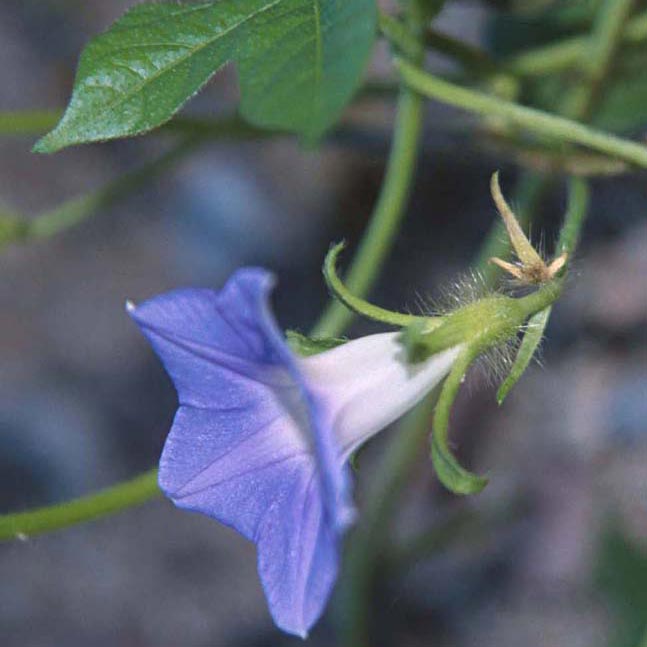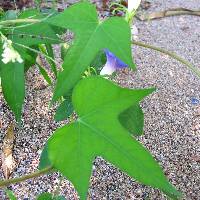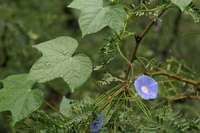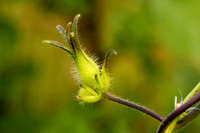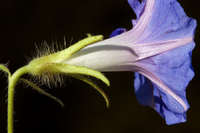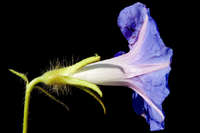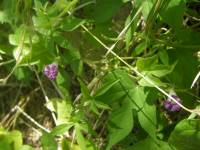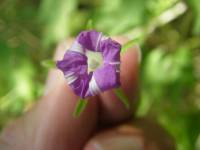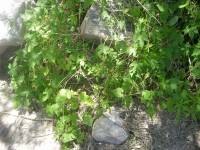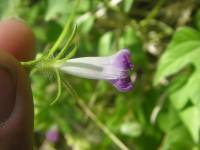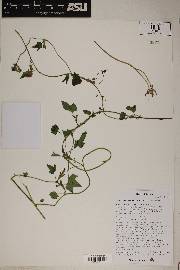|
|
|
|
Family: Convolvulaceae
ivyleaf morning-glory
[Ipomoea barbigera Sweet, moreIpomoea desertorum House, Ipomoea hederacea var. integriuscula A.Gray, Ipomoea hirsutula Jacq. fil., Pharbitis barbigera (Sweet) G. Don, Pharbitis hederacea (Jacq.) Choisy] |
Plant: Annual twining vine; stems twining, densely to sparsely pubescent throughout Leaves: ovate to orbicular, 5-12 cm wide and long, entire to 3-5-lobed, basally cordate, the lobes apically acute to acuminate, pubescent, the petioles to 12 cm long, rarely longer INFLORESCENCE: 1-3(-6)-flowered cymes; peduncles 5-10 cm long; bracts foliaceous, elliptic to lanceolate, 5-8 mm long Flowers: on pedicels 3-7 mm long, erect in fruit; sepals 12-24 mm long, 4-5 mm wide, herbaceous, lanceolate, abruptly narrowed from the rounded base into a narrow acuminate apex, usually curved at least in fruit, the apex sometimes strongly curved, densely long-hirsute at least on the basal 1/3; corollas funnelform, 2-3.7(-4.5) cm long, light blue, the tube white or pale yellow inside, the limb 1.7-3.5 cm wide; stamens 12-15 mm long, included, the anthers 1-1.5 mm long, white; ovary conic, 1 mm long, 3-locular, pubescent; styles 12 mm long Fruit: FRUITS globose, somewhat depressed, 8-12 mm wide, enclosed within the sepals. SEEDS 1-4, 4-4.5 mm long, pyriform, black to dark brown, densely pubescent with short trichomes Misc: Disturbed ground, roadsides; 900-1900 m (2900-6100 ft); Aug-Nov REFERENCES: Austin, Daniel F. 1998. J. Ariz. - Nev. Acad. Sci. Convolvulaceae 30(2): 61. Annual vine 1 - 2 m long Stem: twining and climbing, slender, hairy, and if cut or broken then exuding a milky sap. Leaves: alternate, long-stalked, non-toothed, hairy, 5 - 12 cm long, three-lobed (occasionally five-lobed, rarely without lobes), with indented base, and each lobe base rounded with rounded areas between lobes, but each lobe tapering to a pointed tip. Flowers: many, one to three per leaf axil, short-stalked (shorter than leaf stalk), usually blue or purple, sometimes white, showy, 3 - 5 cm long, radially symmetric, funnel-shaped or somewhat trumpet-shaped. Sepals: five, conspicuously hairy below middle, 1.5 - 2.5 cm long, lance-shaped, widest at base then narrowing near middle and tapering to a long, linear, pointed, recurved tip. Petals: five, but fused into a tube or funnel with flaring or spreading limb, which may be shallowly five-lobed or merely wavy along edges. Stamens: five, attached to inside base of petal tube, not extending beyond petal tube. Pistil: with one, three-chambered, superior ovary; a single style shorter than the petal tube; and one stigma with three small, rounded lobes. Fruit: stalked, two- to four-valved, one- to three-chambered, rounded capsules with two seeds per chamber. Similar species: Ipomoea hederacea is most similar to I. purpurea, except that species usually has unlobed leaves, and the sepals are only up to 1.5 cm long and rarely have very long pointed tips. Other species of Ipomoea in our area have hairless sepals (or sometimes with a few bristles on the edges), white flowers (or some with purple or red coloring in the throat), and only two-lobed stigmas. Flowering: August to October Habitat and ecology: Introduced from tropical America, often found as a weed in agricultural fields, cultivated areas, and other waste ground. Occurence in the Chicago region: non-native Etymology: Ipomoea comes from the Greek word meaning worm-like, possibly referring to the twining and twisting stems, or the twisted flower buds. Hederacea refers to ivy, in this case the similarly shaped leaves. Author: The Field Museum Annual; stems pubescent, 1-2 m; lvs orbicular in outline, 5-12 cm, cordate at base with rounded basal lobes, usually deeply 3-lobed with rounded sinuses (occasionally
5-lobed or entire), the lobes acuminate; peduncles shorter than or equaling the petioles, with usually 1-3 fls; sep lanceolate, commonly 15-25 mm, narrowed from below the middle into a slender, linear, recurved tip, the basal part densely hirsute; cor purple or blue, varying to white, 3-5 cm; ovary 3-locular; stigma 3-lobed; 2n=30. Native of warm-temp. Amer., now established as a weed in waste places, along roads, and in cornfields throughout much of our range, especially southward. July-Sept. (Pharbitis h.) Plants with entire lvs, rare with us but abundant southward, have been called var. integriuscula A. Gray. (Pharbitis barbigera) Gleason, Henry A. & Cronquist, Arthur J. 1991. Manual of vascular plants of northeastern United States and adjacent Canada. lxxv + 910 pp. ©The New York Botanical Garden. All rights reserved. Used by permission. Austin 1998 Duration: Annual Nativity: Non-Native Lifeform: Vine General: Twining introduced annual, stems densely to sparsely pubescent. Leaves: Ovate to orbicular, 5-12 cm wide and long, entire to 3-5-lobed, basally cordate, lobes apically acute to acuminate, pubescent, petioles to 12 cm long, rarely longer. Flowers: Bearing 1-3 flowered cymes, peduncles 5-10 cm long; bracts foliaceous, elliptic to lanceolate, 5-8 mm long; pedicels 3-7 mm long, erect in fruit; sepals 12-24 mm long, 4-5 mm wide, herbaceous, lanceolate, narrowed form rounded base to narrow acuminate apex, curved in fruit, apex sometimes strongly curved, densely long-hirsute; funnelform corolla 2-3.7 cm long, light blue, tube white or pale yellow inside, limb 1.7-3.5 cm wide. Fruits: Globose capsule, 8-12 mm wide, enclosed within sepals. Ecology: Found in disturbed sites, roadsides; 3,000-6,000 ft (914-1829 m); flowers August-November. Distribution: Introduced to much of N. America; from AZ, NM, north to Ontario, CAN, east to ME; south through FL, W. Indies, MEX, C Amer. into S. Amer.; also introduced to every other continent in the Old World. Notes: Distinguished from other regional Ipomoea by being hairy on leaves and stems; leaves divided into 3-5 broad lobes and without glandular dots below; sepals which are relatively linear, gradually narrow to a point, curve out in fruit and have long, spreading hairs especially at the base. Ethnobotany: Unknown Etymology: Ipomoea comes from Greek ips, a worm and homoios, like, referring to plant-s habit, hederacea means of or pertaining to ivy. Synonyms: Many, see Tropicos Editor: SBuckley 2010, FSCoburn 2015 |
|
|
|


